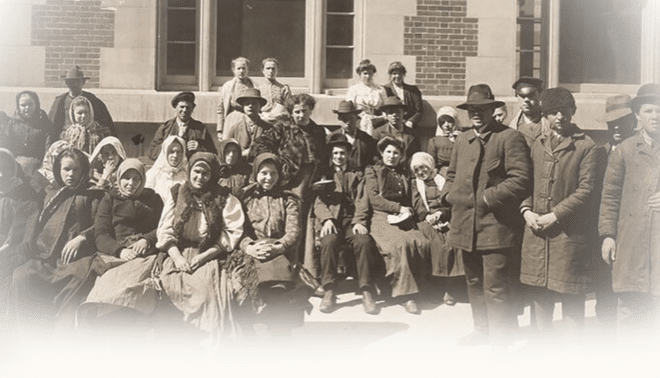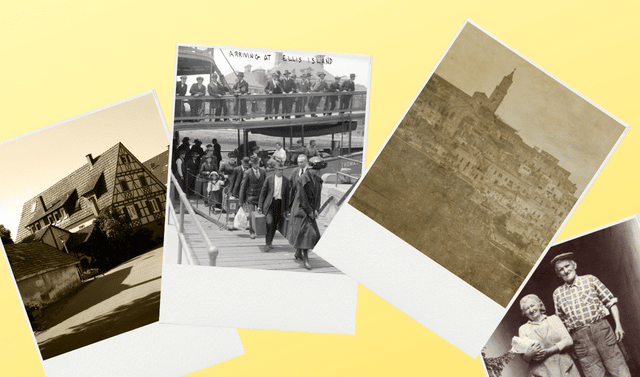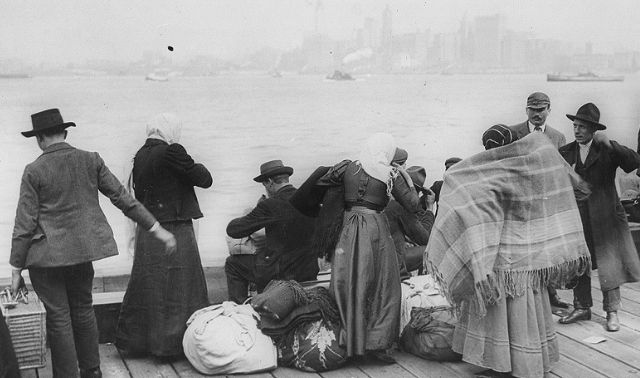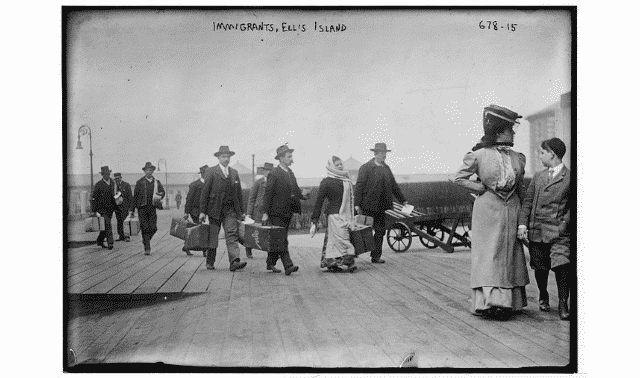Sign up for the Family Tree Newsletter! Plus, you’ll receive our 10 Essential Genealogy Research Forms PDF as a special thank you.
Get Your Free Genealogy Forms
"*" indicates required fields

Q: My widowed great-grandmother Rosalie (Heinz) Thoendel immigrated from Germany to the United States in March 1877 with her four sons. In May 1877, she moved to Columbus, Neb. How do I find the ship and immigration papers? Being a female, was she required to be naturalized? I am at a dead end.
A: Twenty-five percent of immigrants did not get naturalized, or even apply for “first papers” (also called a a declaration of intention, the first step in the naturalization process). Females and children were automatically naturalized under their husband or father until 1922—learn more about women and naturalization in this article from the National Archives’ Prologue Magazine. But a widow may have applied for naturalization on her own. From 1824 to 1906, minors who had lived in the United States for five years and were at least 23 years old could apply for naturalization immediately without first filing a declaration of intention. If the family members applied for naturalization, they may have filed in a local, district, state or federal court. Look for naturalizations in the Platte County court (Columbus is the county seat) and check indexes on the free FamilySearch.org as well as subscription sites Ancestry.com and Fold3.com.
The passenger list should normally be in the book series Germans to America. Unfortunately, I do not find Rosalie and her sons listed.
New York was by far the major port of entry for US immigrants, but other ports are possible, such as New Orleans for someone going to Nebraska (up the Mississippi River). You’ll find a free index for New York arrivals from 1820 to 1892 at CastleGarden.org. Also check the immigration records collection at Ancestry.com, which includes indexes and records for nearly every US port. It may be necessary to view microfilms of ships arriving in March 1877 in New York.
Hamburg and Bremen were the largest German ports of emigration, but the Bremen lists no longer exist. One source that might simplify your search is the Hamburg Direct index, containing the names of those passengers on vessels that sailed from Hamburg directly to an overseas port. Learn more about the Hamburg Direct index at Genealogy.net. A bonus to this index is that if your ancestor is on it, you also find the last place of residence in Europe listed. Ancestry.com has passenger departure records from Hamburg, and the Family History Library has it on microfilm.
Answer provided by Ernest Thode
Q: Based on family stories, census records and other sources, my great-great-grandmother died on a ship coming to America with her husband and seven children in 1880. The origination point was Poland. Her husband and children finally settled in Chicago.
I can’t find any family members on ship records coming to Baltimore, New York, New Orleans and many other ports. I’ve scrutinized each microfilm for the years 1878 to 1882. The first record of the family is in the Chicago census of 1910, which mentions 1880 as the immigration year. I’ve also searched for naturalization records and found none. What would my next step be?
A: Genealogy experts suggest finding all the US records you can before jumping to passenger lists. It sounds like the earliest US record you have for this family is the 1910 census. If they did immigrate in 1880, that’s 30 years of unrecorded time. You don’t say which family members are in that 1910 Chicago census, but children on a ship in 1880 likely wouldn’t be living with their father 30 years later, so verify that you’ve found the right family in the census.
Your family could’ve moved around to any number of places—including Canada—between 1880 and 1910. So start with the earliest known location in 1910 and keep looking in US records. Have you tried searching Chicago city directories and newspapers around that time? Have you searched for death records, wills and probates of every family member? Looked for WWI draft registration cards for any male family members alive in 1917 and 1918? These records will provide clues to help you find the right passenger list. Not every immigrant was naturalized, so citizenship records may not exist for your family. If the 1910 census indicates your family members were naturalized, be aware that pre-1906 naturalizations could’ve been filed in any courthouse, so you’ll want to find out where they resided when naturalized.
A few pointers for finding family in passenger lists:
- Your family stories and the records you’ve found may be wrong about the year of immigration, and scrolling microfilm for every port is like looking for a needle in a haystack. Your time may be better spent searching online databases of passenger lists, such as those on Ancestry.com (your library may offer the free Ancestry Library Edition version) and FamilySearch.org. These will let you look for arrivals at all ports and broaden your arrival year range.
- Many immigrants “Americanized” their names after arrival, so your ancestors may appear on passenger lists with different names than the ones you know. Your continued searching in US records may turn up this name. And searching online passenger databases will let you experiment with spellings and wildcards.
- To learn more about Polish immigrants and develop theories for when and where your family migrated, consult books and references such as Polish Immigrants: 1890 to 1920 by Rosemary Wallner and John Radzilowski (Blue Earth Books) and explore the website of the Polish Genealogical Society of Chicago.
- Your family may have immigrated to Canada and later crossed the border into the United States. Canada started keeping passenger lists in 1865. Ancestry.com has an index to these records; you’ll also find indexes for some years and ports on the Library and Archives Canada website. US border-crossing records for most areas start about 1895 and also are in Ancestry.com’s immigration collection. Keep in mind that people crossing into the United States where no official entry port existed won’t be listed.
Q: How did immigrants arriving by ship get to their final destinations?
A: How our ancestors went from hither to yon depended on the time period and the cost of available transportation. Some immigrants had little choice but to settle in the port city for a while to find work and save up cash before taking off for their final destinations. An ancestor who landed in New York City and ended up elsewhere could’ve used a combination of ways to get there, taking a carriage to a dock, boarding a boat that took him by river to another dock, then another carriage or even a train to his final destination. Depending on their means and how far they wanted to go, our ancestors traveled by foot or in carts, wagons, carriages or coaches along early national roads and paths. See Early American Roads and Trails for descriptions and maps.
One of the most practical modes of transportation, especially for immigrants who arrived after 1800, was to hop on a boat and mosey on down (or up) a waterway. This is why most early settlements were along coastal areas and rivers. The Mississippi River, for example, connected Northern and Southern towns along its path. Tributaries, such as the Illinois, Chippewa, Saint Croix, Des Moines and Rock rivers, allowed travelers to get further inland. Add to that the Missouri River, which joins the Mississippi at St. Louis, and the Ohio River, which joins at Cairo, Ill., and our ancestors could travel just about anywhere. See American Rivers and Waterways for information on historical transportation.
Those who arrived in the mid-1800s or later could travel by rail. By the 1860s, railroads had replaced canals and rivers as the primary means for moving people and cargo, and in 1869, the Union Pacific and Central Pacific united the transcontinental railroad at Promontory Point, Utah.
Answer provided by Sharon DeBartolo Carmack
A version of this article appeared in the January 2010 issue of Family Tree Magazine.
Q: What is an alien registration number? Will it help me find out when my ancestor immigrated?
A: An alien registration number, or A-number, is found on an alien registration card. If your ancestor wasn’t naturalized, he or she may have obtained such a card as part of the Alien Registration Program. As of July 1, 1940, every alien resident over age 14 had to register at a post office. Those entering the United States had to register when they applied for admission.
Each person was fingerprinted and filled out a two-page form called the AR-2. It was attached to another form, the Alien Registration Receipt Card (AR-3), with a perforation. The forms were numbered serially with an alien registration number. The Immigration and Naturalization Service (INS; now US Citizenship and Immigration Services, or USCIS) processed the forms, then the AR-3 went back to the person. He had to carry the card at all times and notify INS of an address change within five days. Address reporting became an annual requirement in 1952, and ended in the 1980s.
Early registrations (July 1940 to April 1944) are on microfilm at USCIS offices in Washington, DC, but they’re not open to the general public. You must submit a written Freedom of Information Act request.
To order copies of AR-2 files, mail a letter or Form G-639, which you can download at www.uscis.gov/files/form/g-639.pdf, to USCIS National Record Center, FOIA Division, Box 648010, Lee’s Summit, MO, 64064. Identify the immigrant’s name, date and place of birth, and Alien Registration number (if known).
Don’t send any money: The first two hours of research time and 100 copies are free; staff will notify you of any charges. But be prepared for a long wait—the search may take several months.
Your ancestor’s alien registration card may not be one of the documents family members were apt to save. If you can’t provide the alien registration number with your request, it may not be filled. But if you’re successful, the cards can offer details on immigration, employment, military service, court records, any arrests, club memberships and other activities. Learn more at www.naturalizationrecords.com/usa/alien_reg.shtml.
Answer provided by Lisa A. Alzo
A version of this article appeared in the November 2007 issue of Family Tree Magazine.
Q: When were passports first issued? Where are passport records located? And, before passports, were records kept of an individual’s travels to foreign ports? Where can these be located?

A: Except for brief periods during and after wartime — Aug. 19, 1861, to March 17, 1862, (Civil War) and May 22, 1918, to 1921 (World War I), passports were not required of US citizens who traveled out of the country prior to 1941. Many Americans, however, obtained them for their own security. Passports were, and still are, issued by the Department of State, and those issued from 1791 to 1925 have been transferred to the National Archives. The originals are housed at the National Archives and Records Administration. Passports are on microfilm at this repository, and there are indexes and registers to help you use them. The Family History Library also has microfilm of these passports. In the “Author” search, type “United States Immigration and Naturalization Service” in the corporate name box, then look for the link to passport applications and indexes.
Early passport applications contain little information, but from 1906 to 1925 they included the name of applicant, date and place of birth, name and date and place of birth of spouse or children, residence and occupation at the time of application, immediate travel plans, physical description and a photograph. Passport applications of naturalized citizens included information about their immigration and naturalization, plus the date and port of arrival, name of ship, and the date and court of naturalization.
For passports after 1925, write to the Passport Office, Department of State, Washington, DC 20520. If the applicant of the passport is still alive, you will need a letter from the applicant; if the person is deceased, you need to provide a copy of the death certificate and state your relationship to the deceased.
Outbound passenger lists are filed with the foreign port of arrival. Check first the catalog of the Family History Library under the country and port city to see if these records still exist. A better resource would be the passenger arrival lists to America when the individual returned from traveling to a foreign country.
Answer provided by Sharon DeBartolo Carmack
A version of this article appeared in the April 2001 issue of Family Tree Magazine.
Q: My grandparents came to the United States in the early 1900s but never became citizens. They died in 1921 and 1950. I have been wondering lately about alien registration. Wasn’t this required yearly? When was it started and are any records available?
A: Aliens were required to register their current addresses and places of employment with the federal government between 1940 and about 1982. The Alien Registration Act of 1940 required aliens to report their address and employment, and to report any change of address immediately. Beginning in 1952, aliens had to report their address annually. Address reporting ended in the 1980s, and only the last or most recent address might remain on file.
You can request these records online from the US Citizenship and Immigration Service’s (USCIS) Genealogy Program. (The USCIS is the former Immigration and Naturalization Service.) Records for those born more than 100 years ago are available. You can order an index search for $20, which is necessary if you don’t have the file number of the record you need. Then you can request the record for a fee of $20 to $35, depending on the type of record you request. See the USCIS Genealogy Program website for more information and instructions on making your request.
Answer provided by Sharon DeBartolo Carmack
Q: Several branches of my family came to United States in the 1860s from Sweden and Germany and England—before Ellis Island. Were these people automatically made citizens or did they have to apply for naturalization? Where would one go to learn of this procedure?
A: Any immigrant coming to the United States in the mid-1800s would’ve had to be naturalized to become a citizen. Not everyone filed for naturalization, so keep this in mind when looking for records. For those who did file, the process was twofold: First, the newcomer would have filed a declaration of intent for citizenship (referred to as “first papers”). After fulfilling the residency requirement, he could then file his petition for naturalization. He had to sign these “final papers”—so if you can find that petition, you’ll have the added treat of seeing your ancestor’s John Hancock.
When male immigrants were naturalized, their minor children also automatically received citizenship. Between 1855 and 1922, their wives did, too. The federal government standardized the naturalization process (including the paperwork) in 1906. Since your ancestors arrived before that, they could’ve filed for citizenship in any court—they might even have started the process in one location, then completed it in another. To cover all your bases, you’ll need to hunt for records at the local, county and state levels.
Fortunately, naturalization indexes and record collections on websites such as FamilySearch.org, Ancestry.com and Fold3.com include some applications from before 1906. It’s easiest to start by searching online collections. If you find your ancestor in a naturalization records index, use the source information provided to track down the original record. If you don’t find your ancestor online, your next step is to run a place search of the FamilySearch online catalog for locations where your ancestors might have petitioned, then look under the naturalization heading to identify records available on microfilm. You can rent the microfilm for viewing at your local FamilySearch Center.
If your online and microfilm searches are fruitless, check archives at all three levels. The records may still be with the court where your ancestor filed, or they may have been sent to a state archives or other repository. Some archives and other official stewards of naturalization records have posted indexes and documents online. A Google search could turn these up, and NaturalizationRecords.com is also helpful.
US Citizenship and Immigration Services has copies of all post-1906 naturalization records. To request those, use the agency’s online Genealogy Program.
Naturalization records can be a gateway to finding your ancestor’s passenger arrival list, as they often tell port and date of immigration (though the earlier the records, generally the less detail they contain). In fact, that’s how I confirmed the family story of my great-grandfather Henry Essel’s 1888 arrival through Philadelphia, enabling me to locate the ship manifest recording him and his family. You can learn more about the naturalization process in They Came in Ships by John Philip Colletta (Ancestry). Library and Archives Canada provides information on Canadian naturalizations.
Answer provided by Allison Dolan
Q: Where do I find naturalization records? I’m looking for information from New York City, about 1910 to 1915.
A. Such a simple question with such a complicated answer! The simplest option is to write to the US Citizenship and Immigration Services (USCIS) <uscis.gov>, established as the Immigration and Naturalization Service (INS) in 1906. Courts around the country forwarded copies of all naturalizations made after that date to INS, which also standardized the process of becoming a citizen. It involved filing a declaration of intention (first papers), fulfilling a residency requirement, then filing a petition for naturalization (second or final papers).
Make your request using form G-639, which you can download from the CIS Web site (click About Us and FOIA on the left). Mail it to the USCIS field office that maintains the records, or the one nearest your home. Don’t send money; staff will notify you if the charge exceeds $25. On the envelope, write “FOIA/PA request.” Send the form, then get comfortable: You’ll be waiting many moons for a reply, sometimes a year or more.
Another option is to visit the National Archives and Records Administration’s Northeast Region facility in New York City. According to genealogist Roger D. Joslyn, this facility has New York City naturalization records and the indexes to them through 1906, plus federal court naturalizations and indexes from 1906. For nonfederal court naturalizations after 1906, visit or write the New York State Supreme Court in New York City’s five counties — Bronx, New York, Queens, Kings and Richmond.
If you don’t know which court to look in, it may be easier to grit your teeth and write to USCIS. You also might check the Family History Library catalog to see if the federal and stare courts’ naturalizations are on microfilm.
You’ve probably guessed that finding naturalization records is a challenge. For help, see American Naturalization Records, 1790-1990: What They Are and How to Use Them by John J. Newman (Heritage Quest,) and Guide to Naturalization Records of the United States by Christina K. Schaefer (Genealogical Publishing Co.).
Answer provided by Sharon DeBartolo Carmack
A version of this article appeared in the September 2004 issue of Trace Your Family History.





